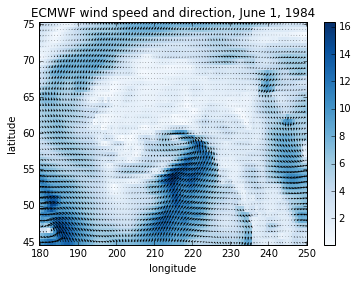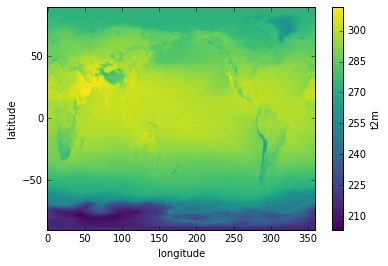Overview
Teaching: 10 min Exercises: 10 minQuestions
How do I perform simple arithmetic operations on xarray objects?
How do I calculate statistics along a dimension of an xarray object?
Objectives
using dimension names rather than integer axis numbers to perform common statistical arithmetic and aggregation functions
Arithmetic
Suppose we want to plot the difference in air temperature between January 1 in 1979 versus 1980. We can do this by taking advantage of xarray’s labeled dimensions to simplify arithmetic operations on DataArray objects:
temperature1 = ds['t2m'].sel(time='1979-01-01T06:00:00')
temperature2 = ds['t2m'].sel(time='1980-01-01T06:00:00')
delta = temperature1 - temperature2
delta.plot()

Note that the subtraction is automatically vectorized over all array values, as in numpy.
Mathematical functions
Now, sometimes we need to apply mathematical functions to array data in our analysis. A good example is wind data, which are often distributed as orthogonal “u” and “v” wind components. To calculate the wind magnitude we need to take the square root of the sum of the squares. For this we use numpy ufunc commands that can operate on a DataArray. Let’s look at our wind datasets:
import xarray.ufuncs as xu
import matplotlib.pyplot as plt
wind = xr.open_mfdataset(r'c:/work/mnt/ecmwf/*wind_AK.nc').sel(time="1984-01-01T06:00:00")
windspeed = xu.sqrt(wind.u10**2+wind.v10**2)
Notice we introduced something new in opening our data. Since we need to access two netCDF files, we used xarray’s open_mfdataset, which allows us to read any number of netCDF files into a single Dataset. Here we use a wildcard search to find the two wind datasets. Note that xarray exposes a wide range of mathematical functions this way, such as sin, cos, etc.
Now to plot the data:
windspeed.plot(cmap=plt.cm.Blues)
plt.title('ECMWF wind speed and direction, June 1, 1984')
plt.ylabel('latitude')
plt.xlabel('longitude')
x = windspeed.coords['longitude'].values
y = windspeed.coords['latitude'].values
plt.quiver(x, y, wind.u10.values, wind.v10.values)

Aggregation
Aggregation methods can be applied to a DataArray over a specified dimension. Suppose we want to calculate the average June/July/August temperature for a particular year. Let’s create a DataArray that slices out those months of data for a particular year:
JJA = ds['t2m'].sel(time=slice('1979-06-01T06:00:00','1979-09-01T06:00:00'))
Now we simply apply the mean aggregation method over the time dimension and plot the result:
JJA.mean(dim='time').plot()

Aggregation
Using the JJA DataArray created above, calculate the maximum air temperature during the JJA period at each latitude and longitude. Plot the result in degrees Celsius as a map. Also, calculate the standard deviation in global air temperature during the JJA period, and plot the results as a 1-D time series.
Key Points
xarray’s labeled dimensions enable simplified arithmetic and data aggregation, enabling many powerful shortcuts